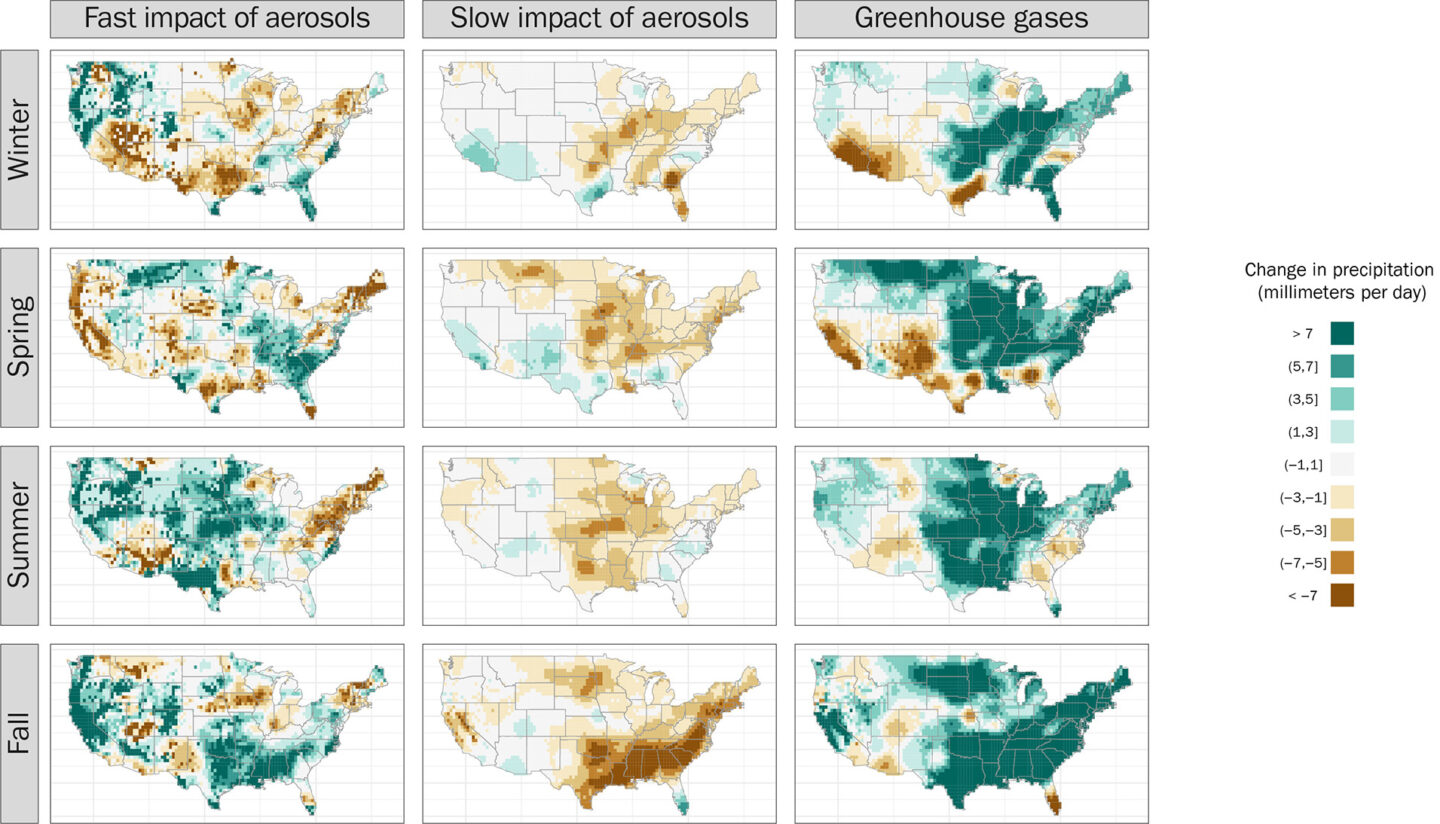Key Takeaways
- In a new study, researchers broke down how human-induced greenhouse gas and aerosol emissions influence rainfall in the United States.
- Greenhouse gas emissions increase rainfall, while aerosols have a long-term drying effect as well as short-term impacts that vary with the seasons.
- As aerosols decrease, their long-term drying effect will likely diminish, causing rainfall averages and extremes to rapidly increase.
We know that greenhouse gas emissions like carbon dioxide should increase rainfall. The emissions heat the atmosphere, causing a one-two punch: warmer oceans make it easier for water to evaporate, and warmer air can hold more water vapor, meaning more moisture is available to fall as rain. But for much of the 20th century, that increase in precipitation didn’t clearly show up in the data.
A new study led by researchers at the Department of Energy’s Lawrence Berkeley National Laboratory (Berkeley Lab) finds that the expected increase in rain has been largely offset by the drying effect of aerosols – emissions like sulfur dioxide that are produced by burning fossil fuels, and commonly thought of as air pollution or smog. The research is published today in the journal Nature Communications.
“This is the first time that we can really understand what’s causing extreme rainfall to change within the continental U.S.,” said Mark Risser, a research scientist at Berkeley Lab and one of the lead authors for the study. He noted that until the 1970s, the expected increases to extreme rainfall were offset by aerosols. But the Clean Air Act caused a drastic reduction in air pollution in the United States. “The aerosol masking was turned off quite suddenly. That means rainfall might ramp up much more quickly than we would have otherwise predicted.”
Traditional climate models have struggled to confidently predict the human impact on rainfall at scales smaller than a continent – and that regional level is precisely where most climate change adaptations and mitigations take place. By using a new method and relying heavily on measurements from rain gauges from 1900 to 2020, researchers were able to more robustly determine how human activities have influenced rainfall in the United States.
“Prior to our study, the Intergovernmental Panel on Climate Change [IPCC] had concluded that the evidence was mixed and inconclusive for changes in U.S. precipitation due to global warming,” said Bill Collins, associate laboratory director for the Earth and Environmental Sciences Area at Berkeley Lab and co-lead author on the study. “We have now provided conclusive evidence for higher rainfall and also helped explain why past studies assessed by the IPCC reached conflicting conclusions.”
Specifically, the study isolates how greenhouse gas and aerosol emissions affect both average and extreme rainfall. Researchers confirmed that increased greenhouse gas emissions, which quickly disperse over the whole planet, cause an increase in rainfall. The impact from aerosols is more nuanced. Over the long term, aerosols cool the planet, which causes a drying effect. But they also have a faster, more local response. That fast impact depends on the season, with aerosols generally reducing rainfall in the winter and spring, and amplifying it in summer and fall over much of the United States.

“The seasonality piece is really important,” Risser said. “For rainfall, the nature of climate change depends on what season you’re talking about, since different kinds of weather systems create precipitation in different parts of the year.”
Some of the conflicting studies looking at precipitation trends of the last century can be explained by how the effect of aerosols offsets the effect of greenhouse gases, and how models and simulations factor in these two driving forces. The researchers noted that tracking aerosols and incorporating them more fully into models and simulations will be important for improving the predictions used for infrastructure design and water resource management.
The United States has already seen examples of recent increases in extreme precipitation, with several intense, record-setting storms in the past few years.
“Thanks to improvements in air quality, the aerosols that shielded us from the worst effects of global warming are declining worldwide,” Collins said. “Our work shows that the increases in extreme precipitation driven by elevated ocean temperatures will become increasingly obvious during this decade.”
###
Lawrence Berkeley National Laboratory (Berkeley Lab) is committed to delivering solutions for humankind through research in clean energy, a healthy planet, and discovery science. Founded in 1931 on the belief that the biggest problems are best addressed by teams, Berkeley Lab and its scientists have been recognized with 16 Nobel Prizes. Researchers from around the world rely on the lab’s world-class scientific facilities for their own pioneering research. Berkeley Lab is a multiprogram national laboratory managed by the University of California for the U.S. Department of Energy’s Office of Science.
DOE’s Office of Science is the single largest supporter of basic research in the physical sciences in the United States, and is working to address some of the most pressing challenges of our time. For more information, please visit energy.gov/science.

